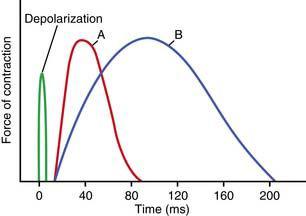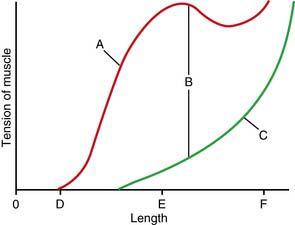A) Actin filaments are overlapping each other
B) Myosin filaments are overlapping each other
C) The myosin filament is at its minimal length
D) The Z discs of the sarcomere abut the ends of the myosin filament
E) There is optimal overlap between the actin and myosin filaments
F) There is minimal overlap between the actin and myosin filaments
8.
Simple diffusion and facilitated diffusion share which of the following characteristics?
A) Can be blocked by specific inhibitors
B) Do not require adenosine triphosphate (ATP)
C) Require transport protein
E) Transport solute against concentration gradient
9.
Excitation–contraction coupling in skeletal muscle involves all of the following events EXCEPT one. Which one is this EXCEPTION?
B) Binding of Ca++ to calmodulin
C) Conformational change in dihydropyridine receptor
D) Depolarization of the transverse tubule (T tubule) membrane
E) Increased Na+ conductance of sarcolemma
10.
A single contraction of skeletal muscle is most likely to be terminated by which of the following actions?
A) Closure of the postsynaptic nicotinic acetylcholine receptor
B) Removal of acetylcholine from the neuromuscular junction
C) Removal of Ca++ from the terminal of the motor neuron
D) Removal of sarcoplasmic Ca++
E) Return of the dihydropyridine receptor to its resting conformation
11.
Which of the following statements about smooth muscle contraction is most accurate?
B) Does not require an action potential
C) Requires more energy compared to skeletal muscle
D) Shorter in duration compared to skeletal muscle
12.
Which of the following best describes an attribute of visceral smooth muscle not shared by skeletal muscle?
A) Contraction is ATP dependent
B) Contracts in response to stretch
C) Does not contain actin filaments
D) High rate of cross-bridge cycling
E) Low maximal force of contraction
13.
The resting potential of a myelinated nerve fiber is primarily dependent on the concentration gradient of which of the following ions?
14.
Calmodulin is most closely related, both structurally and functionally, to which of the following proteins?
15.
Which of the following is a consequence of myelination in large nerve fibers?
A) Decreased velocity of nerve impulses
B) Generation of action potentials only at the nodes of Ranvier
C) Increased energy requirement to maintain ion gradients
D) Increased membrane capacitance
E) Increased nonselective diffusion of ions across the axon membrane
16.
During a demonstration for medical students, a neurologist uses magnetic cortical stimulation to trigger firing of the ulnar nerve in a volunteer. At relatively low-amplitude stimulation, action potentials are recorded only from muscle fibers in the index finger. As the amplitude of the stimulation is increased, action potentials are recorded from muscle fibers in both the index finger and the biceps muscle. What is the fundamental principle underlying this amplitude-dependent response?
A) Large motor neurons that innervate large motor units require a larger depolarizing stimulus
B) Recruitment of multiple motor units requires a larger depolarizing stimulus
C) The biceps muscle is innervated by more motor neurons
D) The motor units in the biceps are smaller than those in the muscles of the fingers
E) The muscles in the fingers are innervated only by the ulnar nerve
17.
Similarities between smooth and cardiac muscle include which of the following?
A) Ability to contract in the absence of an action potential
B) Dependence of contraction on Ca++ ions
C) Presence of a T tubule network
D) Role of myosin kinase in muscle contraction
E) Striated arrangement of the actin and myosin filaments
18.
In a normal, healthy muscle, what occurs as a result of propagation of an action potential to the terminal membrane of a motor neuron?
A) Opening of voltage-gated Ca++ channels in the presynaptic membrane
B) Depolarization of the T tubule membrane follows
C) Always results in muscle contraction
D) Increase in intracellular Ca++ concentration in the motor neuron terminal
E) All of the above are correct
19.
Which of the following decreases in length during the contraction of a skeletal muscle fiber?
A) A band of the sarcomere
B) I band of the sarcomere
E) Z discs of the sarcomere
20.
A cross-sectional view of a skeletal muscle fiber through the H zone would reveal the presence of what?
C) Actin, myosin, and titin
21.
Tetanic contraction of a skeletal muscle fiber results from a cumulative increase in the intracellular concentration of which of the following?
22.
Malignant hyperthermia is a potentially fatal genetic disorder characterized by a hyper-responsiveness to inhaled anesthetics and results in elevated body temperature, skeletal muscle rigidity, and lactic acidosis. Which of the following molecular changes could account for these clinical manifestations?
A) Decreased voltage sensitivity of the dihydropyridine receptor
B) Enhanced activity of the sarcoplasmic reticulum Ca++-ATPase
C) Prolonged opening of the ryanodine receptor channel
D) Reduction in the density of voltage-sensitive Na+ channels in the T tubule membrane
23.
Weightlifting can result in a dramatic increase in skeletal muscle mass. This increase in muscle mass is primarily attributable to which of the following?
A) Fusion of sarcomeres between adjacent myofibrils
B) Hypertrophy of individual muscle fibers
C) Increase in skeletal muscle blood supply
D) Increase in the number of motor neurons
E) Increase in the number of neuromuscular junctions
24.
Which of the following transport mechanisms is not rate limited by an intrinsic V
max?
A) Facilitated diffusion via carrier proteins
B) Primary active transport via carrier proteins
C) Secondary co-transport
D) Secondary counter-transport
E) Simple diffusion through protein channels
25.
Assuming complete dissociation of all solutes, which of the following solutions would be hyperosmotic relative to 1 millimolar NaCl?
E) 1.5 millimolar glucose
Questions 26 and 27
The diagram shows the change in membrane potential during an action potential in a giant squid axon. Refer to it when answering the next two questions.
26.
Which of the following is primarily responsible for the change in membrane potential between points B and D?
A) Inhibition of the Na+, K+-ATPase
B) Movement of K+ into the cell
C) Movement of K+ out of the cell
D) Movement of Na+ into the cell
E) Movement of Na+ out of the cell
27.
Which of the following is primarily responsible for the change in membrane potential between points D and E?
A) Inhibition of the Na+, K+-ATPase
B) Movement of K+ into the cell
C) Movement of K+ out of the cell
D) Movement of Na+ into the cell
E) Movement of Na+ out of the cell
28.
The delayed onset and prolonged duration of smooth muscle contraction, as well as the greater force generated by smooth muscle compared with skeletal muscle, are all consequences of which of the following?
A) Greater amount of myosin filaments present in smooth muscle
B) Higher energy requirement of smooth muscle
C) Physical arrangement of actin and myosin filaments
D) Slower cycling rate of the smooth muscle myosin cross-bridges
E) Slower uptake of Ca++ ions following contraction
29.
An experimental drug is being tested as a potential therapeutic treatment for asthma. Preclinical studies have shown that this drug induces the relaxation of cultured porcine tracheal smooth muscle cells pre-contracted with acetylcholine. Which of the following mechanisms of action is most likely to induce this effect?
A) Decreased affinity of troponin C for Ca++
B) Decreased plasma membrane K+ permeability
C) Increased plasma membrane Na+ permeability
D) Inhibition of the sarcoplasmic reticulum Ca++-ATPase
E) Stimulation of adenylate cyclase
Questions 30 and 31
The diagram illustrates the single isometric twitch characteristics of two skeletal muscles, A and B, in response to a depolarizing stimulus. Refer to it when answering the next two questions.
30.
Which of the following best describes muscle B, when compared to muscle A?
A) Adapted for rapid contraction
B) Composed of larger muscle fibers
D) Innervated by smaller nerve fibers
E) Less extensive blood supply
31.
The delay between the termination of the transient depolarization of the muscle membrane and the onset of muscle contraction observed in both muscles A and B reflects the time necessary for which of the following events to occur?
A) ADP to be released from the myosin head
C) Ca++ to accumulate in the sarcoplasm
D) G-actin to polymerize into F-actin
E) Myosin head to complete one cross-bridge cycle
Questions 32–34
A 55-year-old woman visits her physician because of double vision, eyelid droop, difficulty chewing and swallowing, and general weakness in her limbs. All these symptoms are made worse with exercise and occur more frequently late in the day. The physician suspects myasthenia gravis and orders a Tensilon test. The test is positive.
32.
The increased muscle strength observed during the Tensilon test is due to an increase in which of the following?
A) Amount of acetylcholine (ACh) released from the motor nerves
B) Levels of ACh at the muscle end-plates
C) Number of ACh receptors on the muscle end-plates
D) Synthesis of norepinephrine
33.
What is the most likely basis for the symptoms described in this patient?
C) Depletion of voltage-gated Ca++ channels in certain motor neurons
D) Development of macro motor units following recovery from poliomyelitis
34.
Which of the following drugs would likely alleviate this patient’s symptoms?
B) Botulinum toxin antiserum
35.
The diagrams depict rigid containers composed of two aqueous chambers, A and B, each containing a Na
+ solution and separated by a Na
+-permeable membrane. The panel on the left represents the distribution of Na
+ ions at rest in the absence of any electrical potential. In this scenario, the concentration of Na
+ ions in chamber A equals the concentration of Na
+ ions in chamber B ([Na]
A = [Na]
B). The panel on the right illustrates the effect of a +60-millivolt potential applied across the membrane (chamber B relative to chamber A). Assuming a temperature of 37°C, which of the following expressions best describes the resulting distribution of Na
+ ions between the two chambers?
Questions 36–38
The diagram illustrates the isometric length-tension relationship in a representative intact skeletal muscle. When answering the following three questions, use the letters in the diagram to identify each of the following.
36.
So-called “active” or contraction-dependent tension.
37.
The muscle length at which active tension is maximal.
38.
The contribution of non-contractile muscle elements to total tension.
39.
Smooth muscle contraction is terminated by which of the following?
A) Dephosphorylation of myosin kinase
B) Dephosphorylation of myosin light chain
C) Efflux of Ca++ ions across the plasma membrane
D) Inhibition of myosin phosphatase
E) Uptake of Ca++ ions into the sarcoplasmic reticulum
Questions 40–42
A 56-year-old man sees a neurologist because of weakness in his legs that improves over the course of the day or with exercise. Extracellular electrical recordings from a single skeletal muscle fiber reveal normal miniature end-plate potentials. Low-frequency electrical stimulation of the motor neuron, however, elicits an abnormally small depolarization of the muscle fibers. The amplitude of the depolarization is increased after exercise.
40.
Based on these findings, which of the following is the most likely cause of this patient’s leg weakness?
A) Acetylcholinesterase deficiency
B) Blockade of postsynaptic acetylcholine receptors
C) Impaired presynaptic voltage-sensitive Ca++ influx
D) Inhibition of Ca++ re-uptake into the sarcoplasmic reticulum
E) Reduced acetylcholine synthesis
41.
A preliminary diagnosis is confirmed by the presence of which of the following?
A) Antibodies against the acetylcholine receptor
B) Antibodies against the voltage-sensitive Ca++ channel
C) Mutation in the gene that codes for the ryanodine receptor
D) Relatively few vesicles in the presynaptic terminal
E) Residual acetylcholine in the neuromuscular junction







